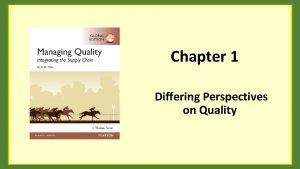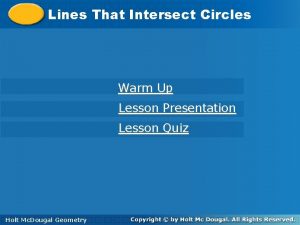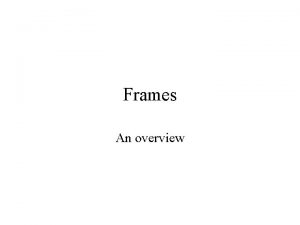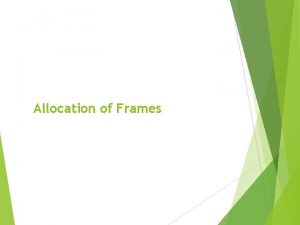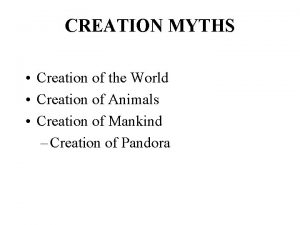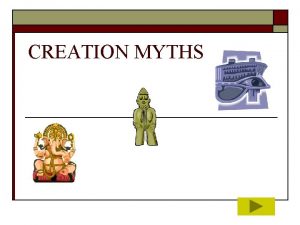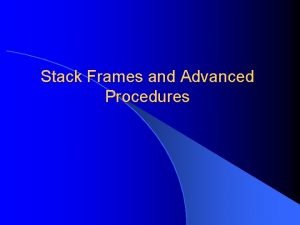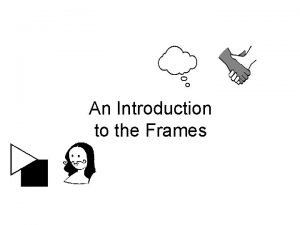The Frames Different perspectives Frames Each creation of













- Slides: 13

The Frames: Different perspectives

Frames • Each creation of an artwork is a journey. • Along the way, stand back from your work and look at it with ‘fresh eyes’. • The Frames are four viewpoints that you can use to examine your art in progress.

• To use the Subjective Frame to examine your artwork in progress you can begin by concentrating on feelings. • Ask yourself ‘Do I like it? ’ • ‘Good art is not what it looks like, but what it does to us. ’ (Roy Adzak) The thought bubble represents the Subjective Frame.

p. 138 • Does this work suggest a physical sensation? • How do you react to the painting emotionally? • The artist hoped the audience would empathise with the subject. • Can you imagine yourself in the same situation? Chris Kearey, student, Portrait of Courage, 2007, oil on canvas, 102 × 152 cm, artist’s collection.

Ask yourself … • Is there something special about you that you can bring to your artmaking practice? • Are there strong emotions that you have experienced in the past that you can remember and use?

One of the most useful questions a creative person can ask themselves is ‘What if …? ’ • ‘What if I used a different medium? ’ • ‘What if I do the opposite of what I had originally planned? ’ • ‘What if my sculpture of a cat had wings and three heads? ’ • ‘What if …? ’

• Think about the artwork you are creating. • Can you see how ideas from the world around you have influenced your art? The two hands shaking represents the Cultural Frame.

• In developing his painting, Portrait of Courage, Chris explored the idea of violence as entertainment in a wider cultural context. • He saw links between today’s popular sports and the gladiators of Ancient Rome. • Men would face injury and death to entertain the masses.

• Looking at artmaking through the Structural Frame we try to understand how a work is put together. • We can begin by asking, ‘Does the work belong to a particular art style or genre? ’ The triangle and square represents the Structural Frame.

p. 143 • As an artist, you can experiment with ways of arranging and placing different elements. • Too much order is boring. • No order is a mess. Alex Mackenzie, 2006, Suburbia series, photograph, 29 × 21 cm, artist’s collection.

• Using the Postmodern Frame students can explore how meanings in their work can shift. The Mona Lisa with a moustache represents the Postmodern Frame. This symbol is a reference to the artist Marcel Duchamp, who famously painted a moustache on a print of Leonardo da Vinci’s Mona Lisa.

• Year 12 student, Tim Playford, examined his work through the Postmodern Frame. • He tried to create images that were ambiguous, leaving the meaning open for people to interpret. Tim Playford, student, Suburbia, 2007, photographs, variable dimensions, artist’s collection.

Summary • Each creation of an artwork is a journey. • Along the way, you may find it helpful to stand back from your work and look at it with ‘fresh eyes’. • The frames are four viewpoints that you can use to examine your art in progress.
 Perspectives of quality
Perspectives of quality What is cultural relativism
What is cultural relativism Things that make us different
Things that make us different Technicolor test
Technicolor test Different angle different story
Different angle different story Argumenterande tal struktur
Argumenterande tal struktur Sound will travel at different speeds in different mediums.
Sound will travel at different speeds in different mediums. Acids and bases have two different faces
Acids and bases have two different faces Lrefraction
Lrefraction Manufactured boards examples
Manufactured boards examples Why do different polymers have different properties?
Why do different polymers have different properties? Farmer plants different crops in a field each year
Farmer plants different crops in a field each year Use the properties of exponents to rewrite each expression
Use the properties of exponents to rewrite each expression Identify each line or segment that intersects each circle
Identify each line or segment that intersects each circle
